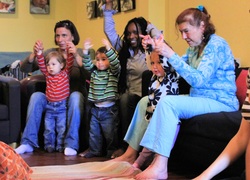 A frequent question I get asked in my Park Slope creative play classes is, "It seems that my one-year old is doing more watching than participating...is she ready for creative play?" The answer is YES! I always remind parents that watching IS participating for many children. Children learn in a variety of ways - through watching, listening, exploring, moving - and one of the primary ways they learn new activities is through seeing those activities modeled by adults and other children. Every week in class we do the same introductory activities. We warm up our bodies, we play a couple games, we sing our "going on an adventure" song. By the second, third, and fourth week, the children know what to expect from this portion of the class because they have been watching me, the other adults, and the other children doing these activities over and over again. Toddlers are extremely interested in routine and eager to participate, and once they have seen the pattern repeated several times they are excited to jump in and show that they know the game, too. That is why we create opportunities for adults to participate in our classes and model creativity. We are all teaching that routine and behavior to the young participants and inviting them to be a part of our multi-generational group. The same goes for the imaginative portion of the class where we spend more time pretending to be characters and telling a story. This is a complex and, many times, totally new concept for toddlers, but they learn how to play in this new way by watching the adults and other children in the room. This concept of modeling creativity is something we encourage parents and caregivers to take home with them. Every week, we give "homework" for the families to try at home. A new color game, or an idea for how to make a home-made instrument. We created this blog as a way to share and document some of these activities so that our families have a resource for fun, creative, playful activities to try at home that will stimulate your child's imagination and creativity. But these activities are not just for your child - they are for the whole family! Children love seeing you try new things and act a little silly. That is how they learn that it is fun to take risks and stretch their creative muscles. It is less important to do an activity "right" than to try something new and model the process of curiosity, exploration, and discovery. Please use the comments to share any additional games or activities that you use at your house, too!
2 Comments
Shariee
17/6/2013 08:19:57 am
What great insite Lauren into the way children experience and embrace the activities in a play setting like you are able to create. I love the way you see parents as educators in the process and gently guide them along the way. Love the blog!
Reply
23/9/2013 05:09:39 am
I love the way you see parents as educators in the process and gently guide them along the way. Love the blog!
Reply
Leave a Reply. |
Authors
Lauren Jost, Director Archives
December 2017
Categories |

 RSS Feed
RSS Feed